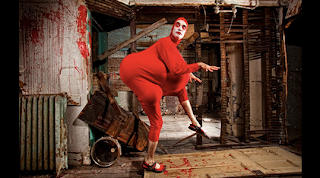
In late February, my colleague and I are embarking on our first ever military civilian dialogue that will take place out of the comfort of American University. We are eager, excited, full of great ideas and frankly scared as hell. That's our cool logo that someone created pro bono for us!!
Yesterday , we took a personal day from work to sit in on a similarly minded (or so we thought) conference. For the sake of confidentiality I won't mention where it took place or who organized it, but I will say that I walked away reeling with surprise at just how far, we in this cross sector field, have to go. The event was organized mainly by military personnel, so the agenda ran sharply, the room was full of impressive high ranking folks and the conversation revolved around the way in which logistically military and civilian NGO's can most effectively collaborate on a certain very specific issue: humanitarian natural disaster relief. This was not what was advertised. Looking back over the description of the event we found the following message: The conference will bring together representatives from the defense, development and diplomacy communities for discussions on how we can better work together to accomplish development goals. This dialogue will inform our collective efforts as we seek to mitigate human suffering both in a deliberate proactive fashion, and in response to crisis, to best help those in need.
Instead, the day basically consisted of a purely logistical tactical discussion on how best to integrate navy medical ships in and around humanitarian crises.
But the real hard questions, the real fundamental issues at hand were completely and totally ignored. My colleague and I were expecting to talk about issues like ethics, political agendas, financing rules and laws, public affairs/relations, the complications of chain of command (something they glossed over but never discussed), the handling of violence if/when a situation turns from humanitarian to armed conflict or policing, inter- and intra-agency competition and more.
I found myself at lunch huddled in a corner with the few NGO peeps that were in the room commiserating about the lack of any really true exchange taking place. I wondered if it was a similar feeling a military vet may experience when coming to a conflict resolution related conference? Or the upcoming dialogue that my colleague and I are working so hard to make inclusive to all.
One other development person in the room related a story about a large river with a high waterfall. At the bottom of this waterfall hundreds of people are working frantically trying to save those who have fallen into the river and have fallen down the waterfall, many of them drowning. As the people along the shore are trying to rescue as many as possible one individual looks up and sees a seemingly never-ending stream of people falling down the waterfall and begins to run upstream. One of other rescuers hollers "where are you going? There are so many people that need help here." To which the man replied, "I'm going upstream to find out why so many people are falling into the river. (I copied this version of the story from Prevention Connection)
I guess the way that story applies is that, in my opinion, the conference felt very much like we were all standing at the bottom of the river talking about how best to pull people out, when the major major issues at play between the defense and development communities were completely ignored/avoided or not considered important at all...
Towards the end of the day, a few NGO directors on projects that have successfully collaborated with the military gave presentations on their work with the military and it was nice to hear their stories. But both were health related NGO's and spoke largely of humanitarian operations.
What about Iraq and Afghanistan, where the vast majority of development/defense collaborations take place everyday? Is that conversation happening anywhere? If it is, it wasn't at this conference, and I am not sure why. If humanitarian operations for immediate disaster response is the only place the military sees room for the NGO community, what hope is there for cross sector multi track peacebuilding?
Conflict resolution practitioner, John Paul Lederach says in The Moral Imagination that in order to create true space for growth we must practice paradoxical curiosity, where two seemingly contradictory worlds can coexist. Beyond Intractability wrote a great summary of The Moral Imagination and paraphrases the idea here: The Practice of Paradoxical Curiosity: Cycles of violence are often driven by polarities. Choices about to respond to conflict are forced into either-or categories: you are either with us or against us. Moral imagination involves the capacity to rise above these divisions and reach beyond accepted meanings. Paradoxical curiosity is a matter of respecting complexity, seeking something beyond what is visible, and discovering what it is that holds apparently opposed social energies together. It involves accepting people at face value, and yet looking beyond appearances and suspending judgment in order to discover untold new angles, opportunities, and unexpected potentialities.
So maybe the lesson here for me, is how can I look beyond the appearances of the conference yesterday? What can I learn from the military community and how can I use that to learn and create more space for inclusivity? I shall ponder that.
I am eager to begin our dialogue, but the amount of outreach we have done in the military community, compared to the number of applications we have received has been disheartening. Our outreach has revolved around addressing:
• Career path motivations
• Power structures to implement change
• Peace-building: the various paths to peace
• Heroism: purpose, effect and your relation to the hero model
• Realism: the inevitability of violent conflict
• Protest: protesting war vs. protesting military
• Security: securing a sovereign nation
These are but a few of the major issues that I believe we must work through in a safe dialogical environment if the development and defense community are going to find room to coexist and collaborate. But that's just me. Maybe others believe we have to figure out a common language of operation before we can ever talk about any ethical/political kinds of things. My fear is that the defense community, in general, never wants to have these conversations.
